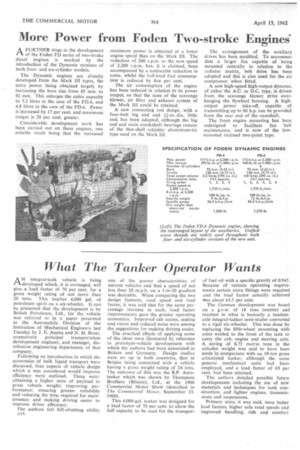More Power from Foden Two-stroke Engines*
Page 66

If you've noticed an error in this article please click here to report it so we can fix it.
AFURTHER stage in the development of the Foden FD series of two-stroke diesel engines is marked by the introduction of the Dynamic versions of both fourand six-cylinder models.
The Dynamic engines are directly developed from the Mark III types, the extra power being obtained largely by increasing the bore size from 85 mm. to 92 mm. This enlarges the cubic capacity to 3.2 litres in the case of the FD.4, and 4.8 litres in the case of the FD.6. Power is increased by 17 per cent, and maximum torque is 20 per cent. greater.
Considerable development work has been carried out on these engines, one notable result being that the increased maximum power is obtained at a lower engine speed than on the Mark III. The reduction of 200 r.p.m. to the new speed of 2,200 r.p.m. has, it is claimed, been accompanied by a noticeable reduction in noise, whilst the full-load fuel consumption is reduced by five per cent.
The air consumption of. the engine has been reduced in relation to its power output, so that the sizes of the scavenge blower, air filter and exhaust system of the Mark III could be retained.
A new connecting rod design, with a four-bolt big end and 1.j-in.-dia. little end, has been adopted, although the big end and main crankshaft bearings remain of the thin-shell reticular aluminium-tin type used on the Mark III.
The arrangement of the auxiliary drives has been modified. To accommodate a larger fan capable of being mounted centrally in relation to the radiator matrix, belt drive has been adopted and this is also used for the air compressor when fitted.
A new high-speed high-output dynamo, of either the A.C. or D.C. type, is driven from the scavenge blower drive overhanging the flywheel housing. A highoutput power take-off, capable of transmitting up to 60 h.p. can be provided from the rear end of the camshaft.
The front engine mounting has been redesigned to facilitate fan belt maintenance and is now of the lowmounted inclined two-point type.




















































































































